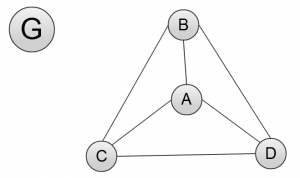Let us think together about a problem of economic growth. In so doing let us reduce the problem into its smallest constituents — I believe.
There are persons A, B, C, and D. A is able to buy and sell produces from at least one of the persons B, C, and D. A, B, C and D thus form a network of people trading with each other. We consider two arbitrary moments of time: t = 0 and t = 1. The four people are currently trading at an initial moment t = 0. Our goal is to make sure that by the completion of moment t = 1, the number of goods and services produced or sold by A increases. That is A will demand for and be able to purchase more goods and services from the other persons in the network. So will the other persons in the network. Consequently, they all will have to produce more.
Our problem now is, how can we stimulate A, and consequently, B, C, and D, into demanding more from the other persons in the network and thereby having the other persons produce more?
To assist our analysis, let us introduce an invisible person G who watches over the network of the four traders. By the end of moment t = 1, his task is to ensure that the number of goods and services traded in the network increases. If, G thinks to himself, I can make A demand more from his trading partners, then the trading partners will produce more. There can be at least two ways for proceeding, G thinks. One is, I give A and the others more money so that if A demands more from his trading partners, his trading partners will respond by producing more. The second way is for me to reduce costs of production so that, with the same capital with which A’s trading partners are endowed, they will be able to produce more. The logic follows for the others too.
In the mean time G chooses the former, and the latter after the completion of moment t = 1 so that by the completion of moment t = 2 production would increase even more. Let me, G says, give my own money to all — that is to A, B, C and D. I call out each one of them and ask them to sell me the things they don’t need and would otherwise find no customers for — things such as their old clothes and furniture. G meets his pledge and all persons have more money than they previously had.
A invests part of the money in producing more goods and services and part of it in purchase of goods and services from his trading partners. Likewise, B, C, and D do the same. And so, it happens. At the end of moment t = 1, production increases and there is higher growth — because G believes for the moment growth can be measured by an increase in productivity or output. Everyone is happy.
The invisible person G, watching over the network of traders, decides to empower A, B, C, and D with capabilities that will enable them to produce more cheaply and efficiently come moment t = 2. So he invests in their training. Furthermore he creates conditions which ensure that A, B, C, and D get their right shares from any trade they participate in. He invests in education, health care, judiciary — you name it.
All this he does in the spirit of placing more money in the hands of A, B, C, and D — that is not “in the hands of prime ministers” — in order to encourage saving and investment that will interact with technology to transform inputs of labor and capital into output — the sum total of goods and services the network can produce over a unit period of time — more efficiently. And so, he does.
My Togolese friend and I had this discussion, in exactly this form, this afternoon. And, in fact, it came to our realization that John Maynard Keynes would believe in it. He writes in his The General Theory:
In so far as millionaires find their satisfaction in building mighty mansions to contain their bodies when alive and pyramids to shelter them after death, or, repenting of their sins, erect cathedrals and endow monasteries or foreign missions, the day when abundance of capital will interfere with abundance of output may be postponed. ‘To dig holes in the ground’, paid for out of savings, will increase, not only employment, but the real national dividend of useful goods and services.
It is without doubt that G would find more reasonable ways than digging holes.
Further reading:



Ahsante! Question: In the current status-quo, does G have to be government, or can it be any invisible “hand” that can invest in this way (say, private investors or social hedge funds)?
Well, depending on the scale of application and the targeted number of people it’s possible for the private sectors and others to assume the role of G.
But I think the government is best suited here. The government can reach places where no one else can. It can undertake activities that are least attractive or too costly for the private sector. Also the facts that the government cannot default and is timeless make it even better. For example, it could use it’s money to finance this idea and the increase in productivity would bring her even more revenue. So I believe it’s not as if it would be money wasted. Far from that, it would be like postponed higher revenue. An even smart way could be devised in which G buys things that can be recycled and turned into new products. This would have another side effect of creating employment — adding more money in the hands of the people. From the sales, G will also get her share. I believe one can work out the arithmetics and come up with an estimated gain (for G and for the A, B, C, and D) and a time horizon for the gain to be realized.
You know, we are not talking about skill-creating tasks or any other such things. Our starting point is now, with the people we have and the technology that we have. From here we have to determine a path. (Kwa sasa, muuza karanga na auze karanga nyingi zaidi. Muuza mbege na auze mbege nyingi zaidi. Mwenye kula karanga na ale karanga nyingi zaidi.)